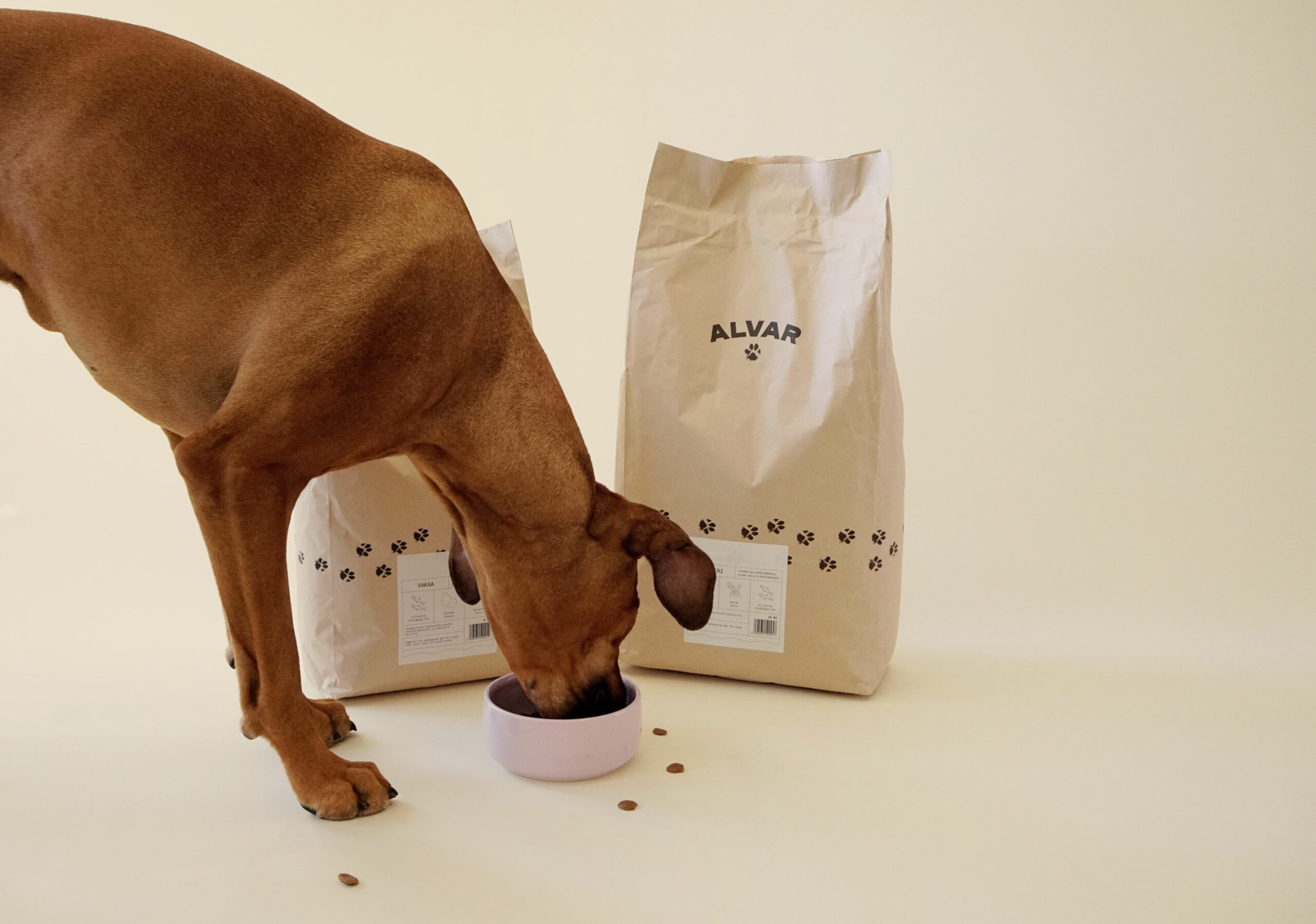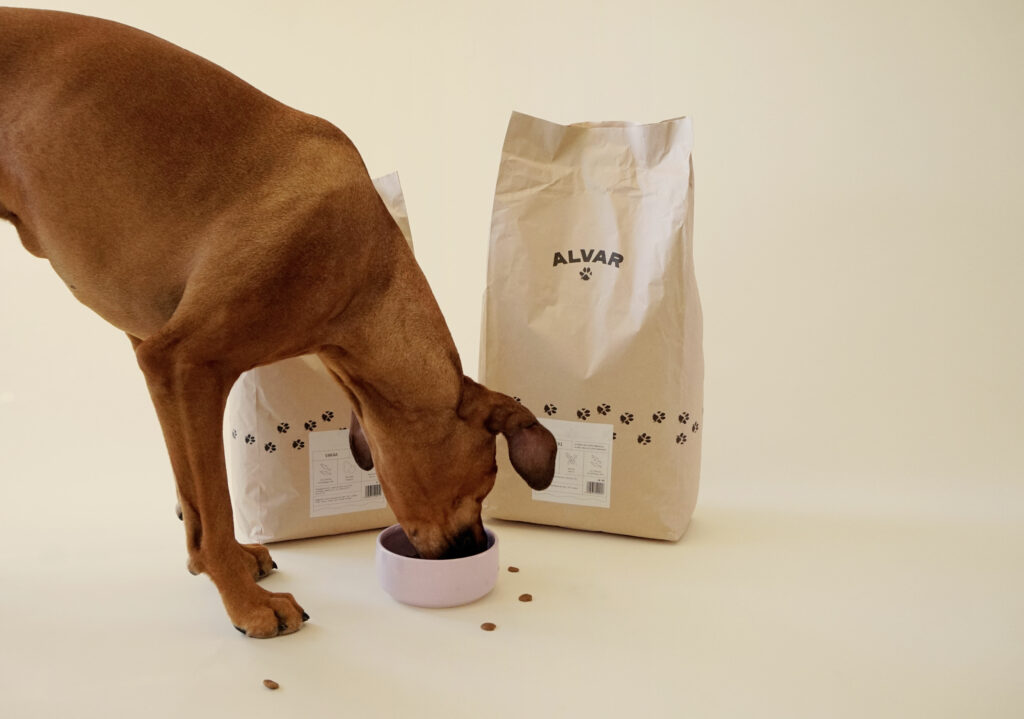
August, 2023
Grain free dog food
Dr. Alvar decided to investigate the grain free phenomenon and below are answers to frequently asked questions about the topic!
Doctor Alvar is here to answer questions around grain free dog food 🩺

For almost two decades, there have been several dog foods with the label “grain-free” or “no grain” in pet stores and online shops. Many dog owners seek grain-free versions, perhaps thinking they are a healthier option for their dog, or because they have heard that grains are harmful to dogs. Dr. Alvar decided to investigate the phenomenon and below are answers to frequently asked questions about the topic!
What does grain-free dog food actually mean?
Simply put, grain-free food means that grains have not been used in the preparation of dog food. According to the labeling practices of the European pet food industry association (FEDIAF), the English terms “grain-free” and “no grain” differ in that the former does not allow any traces of grains in the food, while the latter only requires that grains have not been used in the recipe. This difference can be significant if a dog has been diagnosed with a food allergy to a specific grain, as even small amounts of that grain can cause symptoms.

Does grain-free dog food mean that there are few carbohydrates in the food?
Sometimes it seems that the term grain-free is understood to mean that there are no “carbs” in the food. In practice, however, most dog foods contain sources of carbohydrates in some form. If not grains, then in the form of potatoes, peas, or other vegetables.
Aren’t carbohydrate-rich ingredients in dog food unnecessary fillers?
There are no recommended carbohydrate intake levels for dogs, but using different carbohydrate-rich, plant-based ingredients brings a good source of energy to the food in a well-digestible starch form, and ensures the intake of beneficial fibers. The right fiber composition of the food ensures proper functioning of the digestive tract and supports the formation of a balanced bacterial flora in the intestine. Fibers also help dilute the food’s energy content and support the formation of a feeling of fullness. In addition, plant-based ingredients also provide other beneficial nutrients, such as minerals, trace elements, and vitamins. Especially in dry food, the preparation method of the food requires some source of starch.
If there are carbohydrates in the food anyway, does it matter where they come from?
This is where the individual differences between dogs come in. If a dog has any sensitivities and does not seem to tolerate certain ingredients in its diet, it makes sense to look for better alternatives. A classic immune-mediated food allergy is practically always related to the food’s proteins, which are also found in plant-based sources. For example, a dog can be allergic to the protein of a specific grain or legume. The symptoms of traditional allergy include itching and diarrhea of the skin, and the symptoms of allergy can be avoided by excluding the specific ingredient from the dog’s diet. On the other hand, the unsuitability of the ingredient may also be related to its characteristics, such as poorer digestibility, in which case certain ingredients may cause more gas for some dogs.
There are naturally different nutritional properties associated with the carbohydrate sources used in diets. Oats are particularly linked to several accepted health benefits in human nutrition due to its fiber beta-glucan. Not all of the health benefits of oats, such as lowering cholesterol, are necessarily essential for dogs, but the beneficial effects of beta-glucan on intestinal well-being are also known in dogs. Barley, for example, is known to positively affect postprandial blood sugar regulation and is therefore an interesting source of carbohydrates for weight management and dogs with diabetes. Potatoes, on the other hand, are considered a relatively “neutral” ingredient in terms of nutrition. Potatoes are highly digestible and, in addition to starch, contain some fiber, group B vitamins and minerals, such as potassium and magnesium.
I have read that grain-free dog foods could lead to heart disease. What is this about?
A few years ago, the US Food and Drug Administration began collecting information on a possible link between the occurrence of a specific heart disease in dogs, dilated cardiomyopathy (DCM), and dogs’ diets. It appeared that diets containing a lot of legumes were associated with the occurrence of DCM. Legumes are typically used in grain-free foods, which is why the role of grain-free dog foods in particular was discussed. There is no clear link between diets and the occurrence of the disease, and regular monitoring of the matter has been discontinued. However, the international scientific community is likely to continue to research the best sources of ingredients for dogs.

How do I ultimately choose the best food for my dog?
In addition to the raw materials used in the food, many other factors affect the food’s individual suitability. The energy content of the dog food should correspond to the dog’s activity level so that dosing does not have to resort to extremes. Active dogs can benefit from higher protein content, while slightly more moderate protein levels may be beneficial for dogs with sensitive stomachs. The fat content and choice of fat sources can not only affect the energy density of the food, but also ensure a balanced intake of essential omega fatty acids. The selection of carbohydrate-rich ingredients can affect the fiber composition and protective nutrient content of the food in the manner described above. In addition, it is important that the food is palatable and that the quality of the ingredients is high.
The best food with the most suitable composition for your dog is most reliably found by trying it out. However, avoiding certain ingredients in advance is not necessary, so grain-free food does not have to be used “just in case”.
Alvar’s dry food range includes both grain-free recipes and foods containing oats and/or barley, suitable for dogs with different individual needs. All foods contain the necessary nutrients in the right balance, and the recipes are also designed to support certain nutritional needs through our Dr. Alvar+ compounds.
Through our recommendation engine, you can create a personalised feeding plan for your dog!

